To facilitate passing files between judge and clerk in a paper-based courtroom, the clerk’s station should be located immediately adjacent to the judge, and is usually one riser-level lower. The clerk should also have easy access to case files, evidence, and exhibits, as well as to the jury, to call prospective jurors to the jury box and to swear in impaneled jurors. In more traditional courtrooms, the clerk sits at a desk in front of the judge.
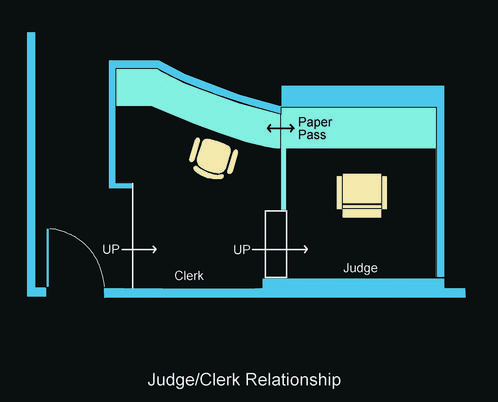 |
The station should be easily accessible from a private, restricted corridor at the front of the courtroom.
The court clerk's station should be adjacent to the bench, facilitating communication with the judge and the transfer of files and documents. In most courtrooms, the clerk is on the opposite side of the judge from the court reporter or witness stand in order to provide balance to the room and to avoid blocking the judge's view of the witness. In some traditional courtroom arrangements, however, the clerk is stationed immediately in front of the bench.
The design and image of the court clerk's station should be compatible with the style and finishes of the judge's bench and other courtroom furniture.
It may be at floor level or elevated on one riser. A floor-level location is more accessible to the handicapped and further accentuates the prominence of the judge's bench, while an elevated location eases the transfer of documents to the judge and presents a better view of the courtroom; these factors should be carefully weighed during the design process.
The court clerk should have a clear view of all courtroom participants, as the clerk takes notes during the proceedings and must be able to see and hear all participants clearly. The court clerk should not obstruct the judge's view of the witness.
The court clerk's station should have the same amount of task lighting as the judge's bench. Work surfaces should be non-glare.
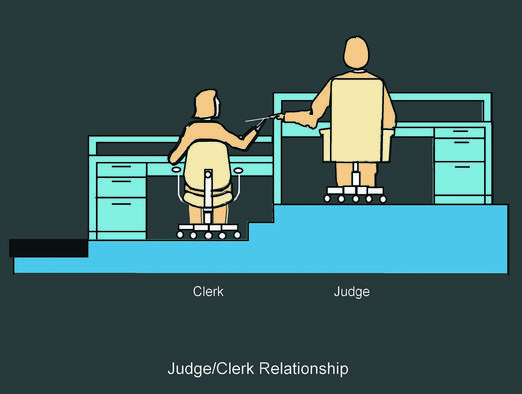 |
The court clerk's station typically includes a shelf for both signing of documents and preventing attorneys from seeing documents on the work surface.
There should be storage areas, either desk drawers or pigeonholes, for forms and paperwork. There should also be an inconspicuous, lockable storage area for exhibits and trial material.
The clerk's chair should be movable, able to swivel, and comfortable for long periods of sitting.
As with the judge's bench, the courtroom clerk's area, need not be accessible immediately but should be adaptable to provide future accessibility. This requires space to accommodate a wheelchair and unobstructed turning space within the work space, an accessible path to the work area which coincides with the normal circulation path to the area, space to locate a permanent ramp or lift, and an accessible desk.
The court clerk's station may have the same duress alarm/intercom system as the judge, providing direct linkage with central security through a foot- or knee-activated button under the work surface. (See reference under judge’s bench.)
A single court clerk's work surface should be approximately 30 to 36 inches in depth by five feet in length. The desk and appropriate storage area must accommodate a large volume of case files in addition to other documents, exhibits, supplies, and sound-recording and computer equipment. For clerk stations requiring two clerks, this space should be expanded to a minimum length of eight to ten feet with some sharing of work surface.
The court clerk's station should be positioned a minimum of four feet from the opposing wall to allow for easy access. The total square footage required is approximately 30 to 40 square feet for a single clerk's station and 55 to 70 square feet for a double clerk's station. One of the most frequent complaints issued by clerks is lack of work and storage space.
Typically the clerk's station will have
- Concealed, silent, supervised duress alarm.
- Desktop computer with silent keyboard and flat panel video display monitor.
- Document scanner and quiet color printer.
- The control console for the sound amplification system may be located at the clerk's station.
- Controls for video and teleconferencing equipment.
- Microphone connected to a mixer and amplifier controlled by the judge or clerk.
- Telephone with silent ring.
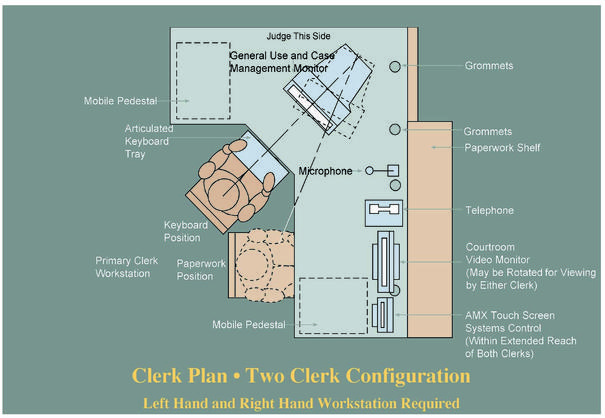 |
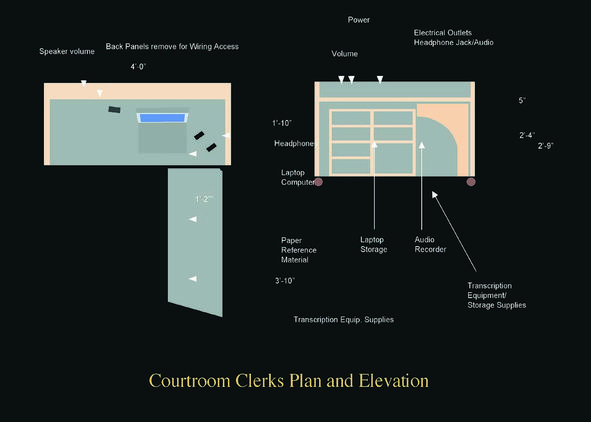 |
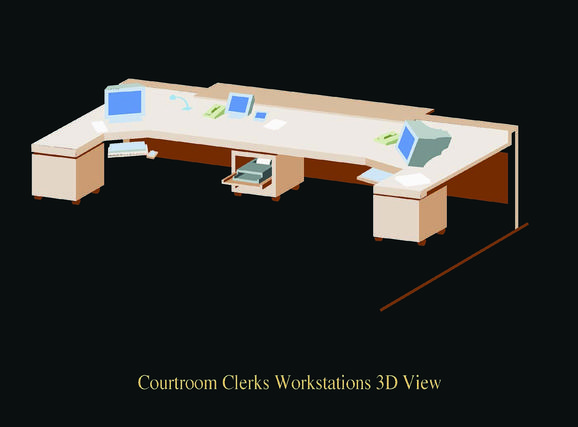 |
